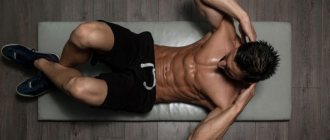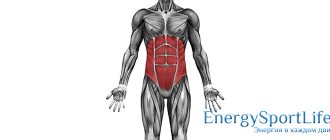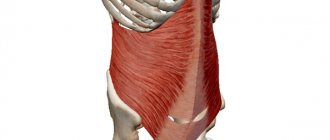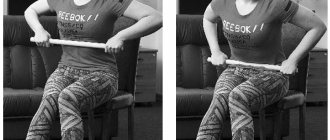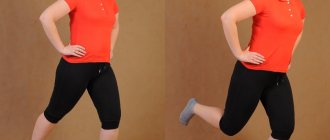Content
- 1 Abdominal exercises
- 2 Warm-up for the abdominals
- 3 Anatomy and morphology
- 4 Exercises 4.1 Exercises for the rectus abdominis muscles
- 4.2 Exercises for the oblique and transverse abdominal muscles
- 4.3 Combined exercises for the abdominal muscles
- 4.4 Tip
Rectus abdominis and posture
Weakening of the rectus abdominis muscles often leads to poor posture. Excessively weak and stretched abdominal muscles shift the load of supporting the spine to the psoas major muscle - which, in turn, is also stretched. As a result, excessive tension is created in the upper back, the shoulders are pulled down and inward, and an excessive deflection appears in the lower back.
Note that a sedentary lifestyle aggravates the problem. In particular, sedentary work causes particular harm to the rectus abdominis muscles. Previously, we talked about how to sit at the computer correctly. Together with the lack of the proper level of daily physical activity and poor nutrition, such changes in posture lead to an accelerated gain of belly fat. Which, again, only stretches the rectus muscles.
How to strengthen your abdominal muscles?
Strengthening the rectus abdominis muscle begins with developing the ability to consciously engage this muscle in work. In simple words, you should feel that the abdominal exercise is performed precisely by the abdominal muscles, and not by the muscles of the lower back and hips. This is extremely important not only for strengthening weak muscles, but also for creating pumped six-pack abs.
To develop the neuromuscular connection between the brain and the abs, you need to start training with a static plank exercise. While in the position, you should tense your abs as much as possible, trying to feel their work. Following the plank should be the usual dynamic abdominal exercises, performed until a characteristic burning sensation is felt in the muscles.
Warm-up for the abdominals[edit | edit code]
Abdominal exercises can be performed at the beginning or end of your workout. If you do them at the end of your workout, you don't need to warm up separately. Perform a warm-up set of abdominal exercises without weights if you plan to use them in the future. If you're starting your workout with abdominal exercises, perform at least one light set of crunches before moving on to more intense exercises. Read more:
Warm-up in bodybuilding
Anatomy and morphology[edit | edit code]
Superficial and deep abdominal muscles
The abdominal press consists of a very complex combination of muscles:
- Rectus abdominis muscle.
- The external oblique muscle is located on the sides of the rectus abdominis muscle.
- The internal oblique muscle is located under the external oblique muscle.
- The transverse abdominis muscle is located under the oblique abdominal muscles.
The listed muscles are part of the muscular corset.
- Abdominals in cross section
- Abdominal Press
The abdominal muscles contract at both ends. Lifting the torso primarily engages the upper abdominal muscles; Lower body lifts primarily work the lower abdominal muscles (though not exclusively; this is also true for the upper abdominal muscles).
The oblique muscles are located on both sides of the abdomen. They support the spine and play a leading role in pelvic rotation.
Unfortunately, it is much more difficult to exercise and develop the lower abdominal muscles than the upper abdominal muscles. Keep this in mind as you perform leg raises, using primarily your upper abdominal muscles. This is what makes leg raises a harder exercise than crunches.
However, the lower abdominal muscles play a major role in protecting the spine and preventing the formation of fat deposits (fat accumulates to a greater extent in the lower abdomen). Therefore, a properly designed exercise program for the abdominal muscles includes exercises not only for the upper, but also for the lower abdominal muscles.
Rectus abdominis muscle - anatomy
The rectus abdominis muscles are paired muscles located on the front surface of the abdomen. Dividing into left and right parts, the rectus abdominis stretches along its entire length, intertwining with the ribs at the top and the pubic bone at the bottom. With the help of tendon jumpers, the muscle is divided into 3-5 segments, forming the so-called “abs cubes”. Usually a person has 6 or 8 cubes, in rare cases - 10.
The main function of the rectus abdominis muscle is to form posture, maintain intra-abdominal pressure and protect internal organs. The key anatomical movement for engaging it is twisting, or pulling the hips toward the torso (as well as the torso toward the hips). The main exercises for developing the rectus abdominis muscle are both abdominal crunches and various leg raises.
Weakening of the rectus abdominis muscle can lead to deterioration of posture, since this changes the angle of the pelvis - which, in turn, can provoke curvature of the spine and back pain. Also, weak abdominal muscles can cause separation of the rectus abdominis muscle - most often during childbirth in women, as well as when a large amount of visceral fat is gained in men.
Diastasis of the rectus abdominis muscles
Diastasis (separation) of the rectus abdominis muscles is a physical deformation of the abdomen, in which the left and right half of the muscles move away from the midline. The expansion can range from 2-3 cm or more. Diastasis appears after pregnancy (especially in the case of the second and third child) and in the presence of significant reserves of internal fat. To the touch, diastasis feels like a hole in the midline of the abdomen.
When the rectus abdominis muscles are separated, training is necessary to restore the elasticity of the muscles - however, performing regular abdominal exercises can be dangerous. In particular, planking is strictly prohibited, as are any heavy abdominal exercises. A positive effect is achieved by combining cardio to burn fat with light exercises for the transverse abdominal muscles (for example, lying pelvic lifts).
Exercises[edit | edit code]
Exercises for the rectus abdominis[edit | edit code]
Anatomy of the abdominal muscles
- Bodyweight exercises:
Crunches Straight crunches - Crunches on a fitball
- Raising the body from a lying position
- Exercises with weights
Crunches with dumbbells or weight plates - Hanging leg raises with weights on legs
- Exercises in the simulator:
Crunching with body lifting on an inclined bench with dumbbells or weight plates - Raising bent legs on parallel bars
Read more:
Exercise machines for abdominal muscles
Exercises for the oblique and transverse abdominal muscles[edit | edit code]
- Bodyweight exercises:
Crunches with body rotations - Twisting with body rotation
- Side crunches
- Leg raise while lying on your side
- Hanging pelvic rotations
- V-turns
- Lying leg rotations
- Exercises with weights
Samson bends
- Exercises in the simulator
Side crunches on a crossover - Turn on the block (“woodcutter”)
- Tilts on the block
Combined exercises for the abdominal muscles[edit | edit code]
- Bodyweight Exercises:
Double Crunch - Diagonal twist
- Combined twist
- Reverse crunch on the ball
- Exercise bike
- Tackles on the ball with a turn
- Exercises with weights
Crunches with a ball - Double crunches with weights
- Exercises in the simulator:
Knee raises on a block - Variants of crunches in simulators
- Crunches in the simulator
-
Plank Abs Exercises - boat
- Exercise vacuum
Advice[edit | edit code]
(a) Normal abdominal wall with developed muscles;
(b) normal abdominal wall with developed muscles and a layer of fat; (c) abdominal wall with insufficiently developed muscles, but without a layer of fat; (d) an abdominal wall with underdeveloped muscles and a layer of fat (protruding belly) Even if you do not have excess fat, weak abdominals can cause your belly to sag. By regularly training your abdominal muscles for several weeks, you can tighten your stomach and make it flat.
If your stomach problems are caused by excess fat, abdominal training will help you tighten your stomach, even if you don't burn an ounce of fat.
The good news is that abdominal training produces results in about a month—and that's a very short period of time. First, you will tighten your muscles, then you will begin to burn fat - and every day your stomach will become flatter and your silhouette more attractive.
With regard to abdominal muscles, women usually set themselves one of two goals:
- Create a very flat stomach with as thin a layer of fat as possible.
- Create a small belly with abdominals covered in a very thin layer of fat.
Some women want to see the relief of their abdominal muscles, while others find it not quite feminine. And although these goals may seem opposite, they have one thing in common: developed abdominal muscles as the opposite of a flabby stomach. So, whatever your goal is, you will have to work hard on your abs.
Exercises for the rectus abdominis muscle
From a formal point of view, the lower abs are also part of the rectus abdominis muscle group. Essentially, the upper and lower rectus abdominis muscles are involved in any exercise that involves moving the core, just like the obliques. The difference lies solely in which part of the musculature takes on the main load and which takes on the secondary load.
In this case, the result is determined more by the correct technique of performing the exercise and the ability to consciously involve the muscles in the work, and not at all by the name of a specific exercise. That is why it is necessary to start training the rectus abdominis muscle with simple and basic movements (lying pelvic lift, plank, twisting), gradually moving on to more complex variations.
Lying pelvic liftThe main goal of the exercise is to stretch the rectus abdominis muscles and “include” them in the work. Perform 10-15 slow rises, paying attention to your breathing. At the top point, tighten your abs, while at the same time trying to pull your ribs inward a little, thus pulling your body into a straight line. |
Elbow plankThe exercise is performed in a static mode, that is, you need to stay in a standing position on your elbows without moving. Perform 2-3 sets of 30-50 seconds each. Try to consciously tighten your abs as much as possible, pulling them into a line - but do not arch your back and keep your spine neutral. |
Crunches on the floorStarting position - lying on your back, legs bent at the knees on the floor. Tighten your core muscles for 5-10 seconds, trying to pull your abs into a straight line. Then clasp your hands, place them behind your head, and, tightening your abs, begin to slowly twist towards your legs without straining your neck. Perform 5-10 times. |
Lying leg raisesRaise your legs up, then slowly lower them down, feeling the tension in your abdominal muscles and making sure that your lower back does not lift too far off the floor (you can do this by placing your palms under your back). Perform 2-3 sets of 5-7 slow repetitions of the exercise. Alternately lowering your legs and bending your knees is a lighter version. |
Bench crunchesA more complex variation of crunches creates additional stress on the upper part of the rectus abdominis muscle. When lifting your body up, make sure that the load is not transferred to your lower back and that your breathing rhythm remains normal. At the top point, tighten your abs. |
Roller crunchesThe most difficult variation of crunches. Strengthens the rectus abdominis muscle and helps define abs. When performing it, it is important to feel that the movement is carried out precisely by the abdominal muscles. |
Reverse crunches on a benchA more complicated variation of lying leg raises. Most of the load falls on the lower part of the rectus abdominis muscle. At the top point, you need to twist your pelvis inward, slightly lifting your lower back off the bench. |
Muscle corset and health[edit | edit code]
When we talk about abdominal muscles, we usually have in mind a certain aesthetic image: ideally, we imagine a flat stomach without excess fat with sculpted muscles. However, nature did not provide us with these muscles for beauty.
The muscle corset performs vital functions, ensuring movement and health. Therefore, they need to be worked out not only in order to create a flat, sculpted stomach. Besides the aesthetic aspect, there are six important reasons why we should work on our abdominal muscles:
- Relieving muscle tension. At night, the lower back muscles often remain tense, as a result of which the spine does not recover. A man wakes up tired and his back hurts. A few minutes of abdominal exercise before bed is enough to relax the lower back muscles and relieve tension in the spine.
- Spine protection. The spine is supported not only by the back muscles, but also by the abdominal muscles. If the abdominal muscles are underdeveloped, this increases tension in the intervertebral discs of the spine, which increases the risk of lumbar fracture.
- Reducing the risk of developing diseases such as type 2 diabetes. Type 2 diabetes develops with age, usually as a result of the accumulation of excess fat in the abdominal area.
- Improving the condition of the gastrointestinal tract. Abdominal training improves digestion and prevents bloating and constipation.
- Improving sports performance. The abdominal muscles play an important role in all everyday activities, as well as in those sports where you need to run quickly or twist your torso. Research shows that athletes with weakened abdominal muscles are more likely to experience flank colic. Strengthening the abdominal wall is a wonderful way to solve this problem.
- Improving the condition of the cardiovascular system. Cyclic abdominal training effectively works the respiratory and cardiovascular systems. At the same time, the knee and hip joints are not subject to excessive stress.
The evolution of the modern woman[edit | edit code]
Predominant distribution of fat tissue in women
Women did not always have so much belly fat. However, a combination of hormonal birth control pills (especially those high in progesterone) and excess consumption of dietary fats and sugars (eg, soda, chocolate, bread, pasta, cakes) altered a woman's genetics. These days, more and more women have belly fat, similar to what many men have. In this case, equality clearly does not benefit women.
With the onset of menopause, decreased production of natural estrogen disrupts hormonal balance. When the level of female hormones decreases, a woman's endocrine system begins to behave like a man. As a result, the distribution of body fat is distorted: fat deposits begin to appear in the abdominal area. For this reason, as women approach menopause, they should double the intensity and volume of abdominal training to minimize the effect of fat redistribution.
Like men, women have fat deposits in the abdomen and waist, but unlike men, these areas should not be where fat accumulates.
Ineffective and dangerous abdominal exercises[edit | edit code]
Incorrect position with back arching Correct abdominal contraction (right) reduces the distance between the chest and pelvis.
Improper abdominal contraction (left) increases the distance between the chest and pelvis and also causes the lower back to arch. There are many abdominal exercises that are not only ineffective, but even dangerous for the spine. Luckily, there is an easy way to tell a good exercise from a bad one. In bad cases, muscle contraction is accompanied by arching of the back; good exercises round the back. Exercises in which you arch your lower back are not able to effectively work your abdominal muscles.
The leg is lifted by the hip flexors, not the abdominal muscles.
Ineffective exercises use the following muscles: psoas major, iliacus, and rectus femoris. You'll feel them working when the exercise causes you to arch your lower back. For example, exercises that require you to lift your legs and keep them suspended for as long as possible (such as scissors) while you lie on your back on the floor break your back. Because the abdominal muscles are attached to the pelvis and not the hips, they cannot move the legs.
These movements are not only dangerous, but also painful. Since arching the back is dangerous for the intervertebral discs of the lower back, the abdominal press strives to straighten the spine by contracting isometrically (that is, statically, without movement). Because the blood supply to that area of the body is blocked during an isometric contraction, the abdominal muscles do not receive oxygen. Impaired blood supply also prevents the removal of lactic acid from the abdominal muscles, which eventually accumulates in them in large quantities. This movement causes an intense muscle burning sensation. In addition, it is dangerous and reduces athletic performance. It must also be remembered that isometric contraction does not help strengthen the abdominal muscles and burn fat.
How to pump up your abs at home?
Sample training program
One of the popular ab workout routines at home is called “10 levels,” or “6 pack of hell,” and consists of 10 bodyweight exercises. It does not require a personal trainer or professional equipment.
With regular training, the athlete moves from the initial level to more and more complex ones. Level exercises must be performed only in the specified sequence. As soon as you learn to perform the exercise without tension, move on to the next level.
- Pulling your knees to your chest in a sitting position. At the initial stage, 1 set of 10 repetitions is enough. Middle stage – 2 sets of 25 repetitions. Advanced – 3 sets of 40 repetitions. As the muscles strengthen, the range of movements increases. Then they move to the 2nd level.
- Raising the knees from a sitting position. Similarly, the load is increased to 3 sets of 35 repetitions.
- Raising bent legs from a lying position. 1st stage - 1 set of 10 repetitions, 2nd - 2 sets of 15 repetitions, 3rd - 3 sets of 30 repetitions. As the muscles strengthen, the angle of leg flexion is reduced to 45°.
- Frog leg raise. Starting position – knees bent at right angles and turned to the sides, feet and arms straight on the floor. Pull your feet towards you so that your heels remain pressed together. Tighten your abdominal muscles, lift your shoulders and arms off the floor. Hold the position for a few seconds. Then straighten your legs at an angle of 45 degrees to the floor, spreading your toes at an angle of 90 degrees to each other (heels together). Stage 1 – 1 set of 8 repetitions, 2nd – 2 sets of 15 repetitions, 3rd – 3 sets of 25 repetitions.
- Straight leg raises from a lying position. It is important to avoid even slight bending of the limbs at the knees. 1st stage – 1 set of 5 repetitions, 2nd – 2 sets of 10 repetitions, 3rd – 2 sets of 20 repetitions. As the muscles strengthen, the amplitude increases.
- Hanging knee raises. In this case, the thigh and shin should form a right angle. 1st stage – 1 set of 5 repetitions, 2nd – 2 sets of 10 repetitions, 3rd – 2 sets of 15 repetitions.
- Hanging bent leg raises. Bend your legs at the knees. Raise them parallel to the floor and lower them perpendicular to the floor without straightening them. 1st stage – 1 set of 5 repetitions, 2nd – 2 sets of 10 repetitions, 3rd – 2 sets of 15 repetitions.
- Hanging leg raises "frog". Straight legs are raised parallel to the floor, and then lowered not completely - at an angle to the floor. Stage 1 – 1 set of 5 repetitions, 2nd – 2 sets of 10 repetitions, 3rd – 2 sets of 15 repetitions.
- Partial hanging straight leg raises. Starting position – raise your legs so that they form an acute angle in relation to the floor and an obtuse angle in relation to the body. Fix your body, then raise your legs higher so that they are parallel to the floor. Return to the starting position. 1st stage - 1 set of 5 repetitions, 2nd - 2 sets of 10 repetitions, 3rd - 2 sets of 15 repetitions.
- Hanging straight leg raises: The limbs and body should form a right angle. 1st stage – 1 set of 5 repetitions, 2nd – 2 sets of 10 repetitions, 3rd – 2 sets of 30 repetitions.
When you can easily perform level 10 home exercises with maximum sets and reps, your abs will be perfect.
How to increase the natural curve of the lower back[edit | edit code]
Psoas Major Action During Back Arching
Many men believe that a visible arch in a woman's lower back is sexier than a flat lower back. The lumbar curve emphasizes the shape of the buttocks and pulls the shoulders back, emphasizing the breasts, which is what many women strive for.
The goals we describe in this book (rounding your butt, pushing your shoulders back, creating a flat stomach) will also improve your health. Increasing the natural curve of the lower back is quite simple, but there is also a downside: increasing unwanted pressure on the intervertebral discs of the lower back.
Powerful hip flexors (the psoas major) increase the natural curve of the lower back, pushing the intervertebral discs forward. This places excess pressure on the back of the lumbar vertebrae, which can lead to pain and damage to the vertebrae due to compression and misalignment.
It's up to you to decide if you want to go this route. If you decide to do this, we recommend doing, in particular, an exercise to develop the strength of the lower back muscles to reduce excess pressure on the intervertebral discs.
Whatever your choice, in this section we will describe techniques for performing abdominal exercises that will allow you to:
- maintain your back in a natural position;
- increase the natural curve of the lower back.
Exercise "vacuum" while inhaling
Technique:
1. Stand straight, feet shoulder-width apart, hands on hips. This is your starting position.
2.Now inhale the maximum amount of air, drawing in your stomach as much as possible, and hold in this position. Imagine that your stomach is touching your spine.
3. One isometric contraction lasts 20-40 seconds. While doing this, try to breathe in a normal manner.
4.Then exhale and return to the starting position.

